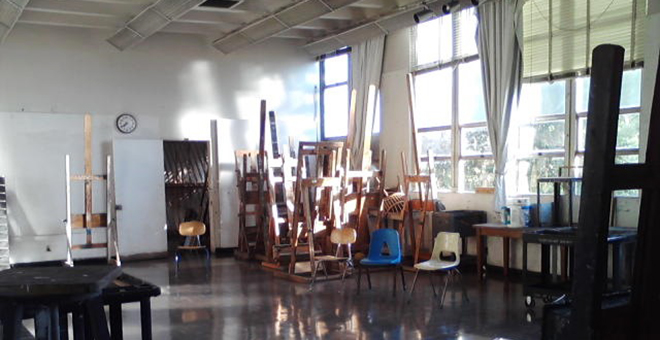Studio Practice

Degrees Offered
-
- Undergraduate Programs
- Bachelors of Art: Concentration in Studio Practice (BA)
- Minor Studio Art
- Undergraduate Programs
About the Studio Practice Program
The BA in Art Studio Practice concentration allows students to pursue a general study in the visual arts, or to create their own curriculum combining studies in visual arts with other fields. For students preferring a broad art background instead of an intense specialization, this program provides students with a variety of art experiences.
Students enrolled in the Studio Practice concentration are not necessarily preparing for a career in art or design, although many use the program as preparation for graduate level studies. The required studio work is intended to intensify awareness of visual art forms and introduce a variety of technical processes and theoretical approaches. Concentrations and emphases are designed to offer opportunities to study digital media art, photography, pictorial art and spatial art. Studio Practice also provides a basic program leading to a teaching credential in art.
Admission to the BA programs is open to all University students.
In addition to general education (GE) coursework, the BA degree in Art, Studio Practice Concentration requires coursework in core courses that constitute a general preparation for the major, concentration, or emphasis.
A BA in Studio Practice is a flexible and interdisciplinary degree that equips students with a range of artistic, technical, and critical thinking skills. A BA in Studio Practice offers versatility and allows students to shape their career based on their skills, interests, and willingness to explore interdisciplinary opportunities.
With a Major in BA in Studio Practice you will learn:
Creative Skill Development – Students refine their technical abilities across multiple media (painting, sculpture, digital art, etc.), developing a unique artistic voice.
Critical Thinking & Problem-Solving – Engaging with conceptual and theoretical frameworks
hones the ability to think creatively and critically.
Interdisciplinary Approach – Many BA programs encourage blending disciplines, allowing
students to explore intersections with technology, design, education, or business.
Professional Practice & Portfolio Building – Students gain experience exhibiting work,
documenting projects, and preparing professional portfolios.
Collaboration & Communication – Working with peers, faculty, and the community enhances
teamwork and communication skills.
Flexibility for Diverse Careers – Unlike a BFA, which is often more focused on artistic mastery, a BA allows for broader academic exploration, including business, curatorial studies, or arts education.
Exposure to Art History & Theory – Understanding historical and contemporary contexts enhances the ability to engage critically with art and culture.
Career Paths for BA Studio Practice Graduates:
- Independent Artist – Exhibiting work, commissions, and artist residencies.
Illustrator – Working in editorial, advertising, book publishing, or digital platforms. - Graphic Designer – Applying visual design skills to branding, marketing, and digital content.
- Multimedia Artist – Creating digital content, video art, and interactive installations.
- Art Fabricator/Studio Assistant – Assisting established artists in production.
Muralist/Public Artist – Creating site-specific work for urban and community spaces. - Curator or Gallery Assistant – Organizing exhibitions and working in museums or galleries.
- Art Handler or Preparator – Managing installation and conservation of artworks.
- Arts Administrator – Working in arts organizations, nonprofits, or cultural institutions.
- Museum Educator – Developing art programs for museums and schools.
- Archivist or Collections Manager – Preserving and cataloging artwork for institutions.
- Art Therapist – Using art in therapeutic settings (requires additional certification).
- Teaching Artist – Leading workshops and community-based art programs.
- Cultural Policy & Advocacy – Promoting arts funding and policy development.
- Creative Entrepreneur – Running an independent studio, gallery, or design firm.
- Freelance Designer/Illustrator – Working independently with clients.
- Art Event Coordinator – Organizing art fairs, workshops, or pop-up exhibitions.